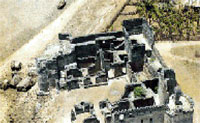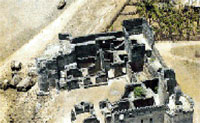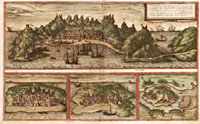
The treasure that continues to resemble strong Hadramawt influence:The beautiful Island of Kilwa – Tanzania [Archives:2004/748/Culture]
June 21 2004
 |
 |
 |
For the Yemen Times
[email protected]
The wealthy island city of Kilwa, an island off present day coast of Tanzania, was the most important of thirty five trade sites on the Indian Ocean during 11th through 16th centuries AD. From 1110 to early 1500 it was also an important center of Islamic learning. Kilwa and all other centers were politically independent, but spiritually and commercially linked to centers in Arabia, notably Hadramawt in Yemen.
On any given day, Kilwa's fine harbor was packed with Arab dhows loading and unloading goods that circulated through the ecumenical trading sphere. Colonists, resident merchants, and visiting traders, and scholars from Arabia and India mingled on its streets with locals.
In the 9th century a Swahili owner sold the island to a Persian prince of Shiraz named Ali bin Al-Hassan who built Kilwa most likely upon the site of the ancient Greek colony of Rhapta. From the 11th century to the early 15th century Ali bin Al-Hassan managed to create a powerful city Kilwa Kisiwani, what was to become a major trading center along east African coast.
He also built a great mosque, established close trading links with the interior of southern Africa as far as Nyasaland and Zimbabwe. Kilwa Kisiwani was to become the main trading port of the Indian Ocean. Its wealth came from the exchange of gold and iron from Great Zimbabwe and other part of Southern Africa, ivory, and slaves from mainland Tanzania, textiles, jewelry, porcelain and spices from Asia. By the 13th century Kilwa had become the most powerful city along the East African Coast, exercising political and trading domination as far as Pemba Island in the north and Sofala, present day Beira in Mozambique, in the south. An Arab chronicle gives a list of over forty sovereigns who reigned at Kilwa in a period of five hundred years. Pedro Alvares Cabral, the Portuguese navigator, was the first European to visit it. His fleet, on its way to India, anchored in Kilwa in 1500. Kilwa was then a large and wealthy city, possessing, it is stated, three hundred mosques.
It is the offshore location and the tidal currents that isolate the island from the mainland and protect it from a landslide attack. Thus Kilwa Kisiwani, that is old Kilwa which means “on the island”, is graced with the two most magnificent medieval architectural monuments, one of which is the Great Mosque with its arched, vaulted and domed extension which was constructed in the early fourteenth century, and following collapse was rebuilt a hundred years later. The other is the palace complex known as Husuni Kubwa, which with its courtyard annex and the adjacent Husni Ndogo was built in the same period.
Husuni Kubwa, as spacious as any roofed stone building south of the Sahara until modern times, appears to have been intended as a palace, combined an emporium and warehouses under the sultan's control, of al Hasan bin Sulaiman of the Mahdali dynasty. It was probably this very sultan who commissioned the building of the Husuni complex. Here a stone inscription commemorated his power and virtues together with the title Abu al-Mawahib, the “Father of Gifs”. It was him whom the celebrated traveler Ibn Battuta visited, having heard like other scholars and students of the splendor and hospitality of the court of Kilwa, known well beyond the Equator, to this southerly limit of the Muslim faith. This Sultan's wealth, generosity and praises are further sung in the Kilwa Chronicle, written down two centuries later during revival which is remembered as the “New Rain”.
Ibn Battuta left Mogadishu by sailing south towards the land of the “Sawahil” (coasts) and the city of Kilwa, which is one of the cities of the land of Zunuj, he observed. After an overnight stay in Mombasa, Battuta continued on to Kilwa by ship. Most of the inhabitants of Kilwa were black, and many had decorative scars on their faces, he noted.
Battuta was amazed by the beauty of Kilwa, and writes further:
“The city large and elegant, its buildings as typical along the coast, constructed of stones and coral rag. Tapestries and ornamental niches covered the walls and the floors were carpeted. Their robes are a simple loincloth, their dinner millet porridge”
There was plentiful rain in the region, noted Ibn Battuta. Kilwa's glittering wealth thoroughly impressed also an European scribe who arrived in Kilwa harbor with Portuguese explorer Pedro Alvares Cabral in 1500. The man reported seeing fine houses made of coral stone, the most imposing of which was the Sultan's 100-room palace. In this land, the scribe wrote, there are rich merchants and there is much gold and silver and amber and musk and pearls. Those of the land wear clothes of fine cotton and of silk and many fine things.
Kilwa derived its prosperity from its monopoly of the flow of goods in and out of the Zambezi River region in the southern African interior. It was the major exchange point for gold, ivory, iron and coconuts from the Kingdom of the Mwene Mutabe, jewelry and textile from India, and porcelain from China. Kilwa's ruler maintained a mint that produced coins in several foreign denominations, and exacted stiff tariffs from visiting Arab and Indian traders.
Kilwa's local culture illustrates the close association between commerce and the spread of social and religious customs across the map of the Old World. Islam permeated daily life in Kilwa. Many of the cities African-born businessmen claimed descent from aristocratic Arab and Persian families. The city's multi-storied houses were architecturally of Middle Eastern design. Portuguese visitors in the 1500s compared Kilwa's mosque built between the 1110s and 1400s to Spain's famous Cordoba Mosque.
There are three Kilwas: The oldest is Kilwa Kisiwani, which lies on a small island. This is where the ruins of the medieval city of Kilwa are located, and from where the legend of King Solomon's mines originated. Kilwa Kisiwani is famous for its ruins, and the finest and best preserved Islamic architecture. A small fishing villages along the coast lie unchanged. Kilwa Masoko is now a regional headquarters. A market is held daily on the square at Kilwa Masoko. Men in white robes and women and black veils gather together to barter fresh produce and a variety of other products. Kilwa Kivinje was one the southern caravan routes from Lake Nyasa.
The clear but shallow waters at the harbor of Kilwa Masoko.
Ibn Battuta had arrived by dhow at this very channel. This side is part of the East African mainland and the mangrove-fringed island over there is Kilwa. It has an additional name of “Kisiwani”, on-the-island, in order to distinguish it from its successors Kilwa Kivinje. Ibn Battuta visited Kilwa in 1331 and Portuguese sailors, about 170 years later, described Kilwa as a flourishing and powerful city. The wind was blowing now constantly and moderately from south-south, and the beach burns its memory. The winds bring news, although smoke forgets the earth, it named impossible mountains. The fresh green island mangrove shores are gleaming in a distance. The sun is radiating from a friendly blue sky. A wonderful silent and fresh sea breeze carries across the Ocean and back in time. There were pillars that fell, leaving a blue space. Clouds were rising like leaves. Then, far out, at sea, in a sparkling shower arrows of rain arch from the emerald breakwater. The fortification reflects Kilwa's more recent history, when the Portuguese had destroyed and sacked the proud city of Kilwa in 1505. At this vitally important harbor site, they constructed a fort with an observation tower and abandoned it in 1513. By the end of the 18th century, Omani rulers established a trading post on the island of Kilwa. From 1843 Kilwa Kivinje, 20 km further north on the mainland, proved to have a more adequate harbor location.
Since that time this “gereza”, the prison, has been reduced by wind and weather into mysterious, romantic ruins. In the inner courtyard, next to the Portuguese tower, a young baobab on the towers platform lifts its leafless branches above the crenellations. A few steps further is the Great Mosque. Its building reflects Kilwa's economic success and decline over the centuries. The northern part, roofless today, stood there in the 12th century when the gold trade with Zimbabwe started. It used to have a flat roof, supported by wooden pillars. In the 14th century the demand for gold in India and Europe rose, and, in accordance, Kilwa's wealth. The mosque was enlarged considerably, and the city could afford a domed and vaulted roof, which rested in thin, eight-sided stone pillars. Though elegant, they were not very stable and caused parts of the roof to collapse. In the Middle Ages they were replaced by pillars built of coral limestone blocks.
Two buildings are especially striking here. They are considered to be the sultans' palaces. The southern palaces may have been the one that fell victim to the Portuguese assault in 1505. The east and west wings of the Palace had long, narrow rooms. Their width was limited by the measure of the standard mangrove poles by which the ceilings were covered. Also on the upper floor were living quarters. Several of the other buildings, which gave new life to Kilwa from 1780 onwards, seem to have been defensive in character. Thick baobabs, with their mighty silver-gray trunks that take a lot of room between remains of the palace, underline the heaviness of the dark gray ruins. A few smaller mosques are scattered around the city area.
Many of the town houses are now gone because they were constructed of less durable materials. Husuni Kubwa is the great palace that stands here, since about 1300, on a protruding, hardly conquerable rock ridge. It overlooks the straits between the island and the mainland: hallways, galleries, bathing places, staircases and rooms. Reefs that are traveling with clear power in the sun. Rivers envying the sea, tired of being crossed. From the commanding position on this side, every intruder sailing in from or out into the ocean could be sighted. There was fear and pride of age before beauty. Just to the east across a deep gully, lies Husuni Ndogo, the small palace. Both palaces were abandoned already in the 14th century. Its 13th century stairs lead to the sandy sea shore. The area is now covered with mangroves, yet it is very well imaginable, how, in former times, that dhows were steered onto the shore, and their goods were unloaded. The seven seas sang for them, sunlight entered their hands for the purple – blue water. For those to whom history is the presence of ruins, there is green nothing. Then breeze rustles the palms of the cool road.
In the meantime, low tide has come. A walk along the wide, sandy beach strip on the way back to the harbor. Uncounted crabs flee toward the water into the shelter of the mangrove thicket, as soon as they sense steps. The sun has sunk rather low. A marvelous day, a day that has taken into present times and into the many ups and downs of centuries past. Ibn Battuta reported about the friendliness of Kilwa's inhabitants. In this respect nothing much has changed here during the past seven centuries. The fisherman, hearing the cries from the ochre shores, yearn for a sound that is missing. Life seems too fragile, all its shadows are seasonal, including pain. This does not pretend to be the whole story in respect to either the origin of Kilwa about twelve hundred years ago or the reign of its ruler al-Hasan bin Sulaiman (1315-35). The Ocean has changed around every name, tree and man, since the ocean had to live because it was life.
Did you know?
* Archeological investigations at the Kilwa site began in earnest in 1955
* The site of Kilwa was named a UNESCO World Heritage Site in 1981.
* Kilwa (Quioa), used to be a seaport of German East Africa. It is situated about 200 m south of the island of Zanzibar, on the coast of present day Tanzania.
* The republic of Tanzania was created by the union of the former Tanganyika and islands of Zanzibar. Situated in East Africa it is bordered by Rwanda, Uganda, Kenya, Burundi, the Democratic Republic of the Congo, Zambia, Malawi and Mozambique. Dar es Salaam is the country's capital and most important port. Arusha, Dodoma, and Mwanza are other important cities.
* The main economic sectors are: agriculture, tourism, telecommunications, mining, forestry, and energy industries. The main export items are coffee, sisal and tea, cotton, cashews nuts, minerals, tobacco products. Main imports are consumer goods, machinery and transport equipment, crude oil, and industrial raw materials.
——
[archive-e:748-v:13-y:2004-d:2004-06-21-p:culture]


